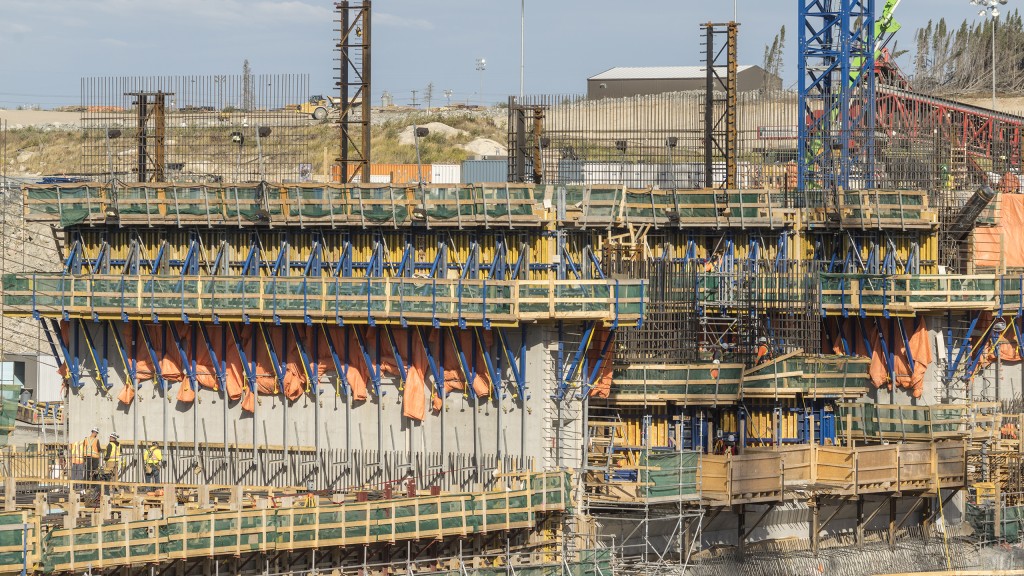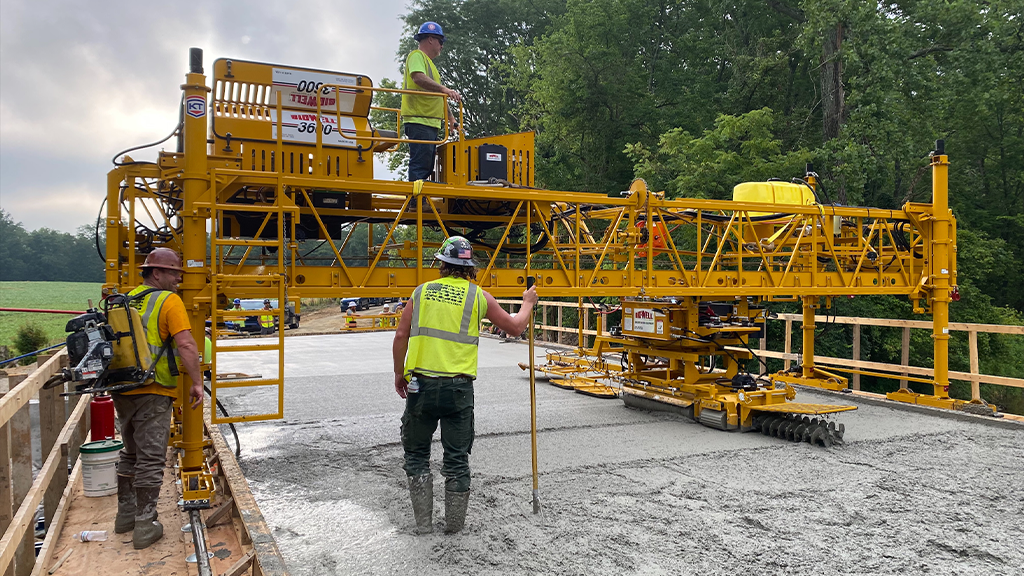
The Keeyask Generating Station, which is under construction in northern Manitoba, will provide 695 megawatts of capacity and produce an average of 4,400 gigawatt hours of electricity each year for use in Manitoba and for export. The project is located 725 kilometres north of Winnipeg on the Nelson River. Getting material and support to the site is difficult over the rough terrain, and due to the size of the project, the amount of equipment required at any one time is also a challenge.
The project is a collaborative effort between Manitoba Hydro and four Manitoba First Nations. BBE Hydro Constructors LP (BBE), a consortium of Bechtel, Barnard Construction and EllisDon, was contracted to place the 430,000 cubic yards of concrete required for the multiple structures.
The massive project includes a powerhouse/service bay complex on the north side of the river and the seven-bay spillway on the south side, with 1.5 km between the two sets of structures. There will be more than 23 km of dykes on the north and south sides of the reservoir.
Doka was chosen as the formwork supplier due to their strong role in working with project time constraints. Specialists from Doka's North America major projects team and their Western Canada sales team worked tirelessly for months using 3D-printed models and state-of-the-art 3-D CAD programs to put together a quotation package that went above and beyond the competition, the company says.
All forms were designed for full liquid-head concrete-pour pressure. Special quality requirements include fair-faced concrete (which requires no further finishing), and SCC (self-consolidating concrete) mix design. To work under these conditions, the contractor hired two Doka field service technicians and a Doka site engineer to stay at the camp on a 21-day-in/7-day-out rotation.
The complex draft-tube formwork includes the Doka Top 50 large-area formwork system, Staxo 100 load-bearing towers and D22 dam formwork.
The D22 system is used on single-sided, mass pour applications. It has a "rollback" feature that allows formwork panels to be moved away from the concrete by 750 mm to gain access to the concrete face to clean the panels and do necessary concrete patch work, before re-setting to the next pour/lift/location.
Since each formwork structure is split into multiple lifts, the D22 rollback feature was an advantage as it allows for quicker resetting of forms to the next lift. This means quick cycling of the formwork on multi-pour applications: set formwork, install rebar, pour concrete, move forms to the next location, close, set rebar and pour concrete again. Time for formwork resetting directly contributes to the overall construction time.
With its ease of use, the formwork is easily transferred from one area to another when finished on a particular section, meaning less equipment is on site. It also provides for worker safety with large work platforms integrated into the design. The system is efficient as it allows for cycling and reuse of equipment.
Telebelts provide numerous advantages for a mega-project
BBE worked closely with Putzmeister to determine the equipment needed to best place material for the project. They chose the Putzmeister Telebelt TB 200 and TB 130 Telescopic Belt Conveyors.
"Given the massive amount of large aggregate required for such a big project, we decided a TB 200 and TB 130 would be the best solution for Keeyask," says Robert Weiglein, special application business manager for Putzmeister America. "The durability and simplicity of the Telebelts means the units can keep working in all conditions with all types of concrete without experiencing plugging or expensive wear on pipeline equipment."
The 237,220-pound (107,600-kg) TB 200 was delivered to the remote site via four truckloads and assembled by three Putzmeister employees, in addition to a team of four BBE ironworkers and a crane operator. It took two weeks for the crew to assemble and test the machine.
The Telebelts placed material for all areas of the seven-unit powerhouse/service bay complex on the north side, as well as the seven-bay spillway on the south side. The long reaches of both Telebelts - 200 feet (61 m) horizontally for the TB 200 and 126 feet 3 inches (38.5 m) horizontally for the TB 130 - were crucial in constructing the massive structures.
Also a challenge, the jobsite itself is massive, spread out over many miles. It takes about 20 minutes to transport equipment from the powerhouse to the spillway, then another 20 minutes to transport equipment to the batch plant. Having efficient, reliable equipment is crucial to save time and keep operating.
Over the course of the job, the Telebelts are placing aggregate ranging from 40 to 80 mm (1.6 to 3.1 inches). The large aggregate and dry mix would be impossible to pump using a concrete pump; the Telebelts are able to handle these mixes without any difficulty.
"When building a massive structure, like a dam, millions of cubic yards of concrete are required," explains Weiglein. "The Telebelts allow each cubic yard to have a lower cement content, lower/no chemical additives, reduced sand content, lower cement content, and lower water-to-cement ratio, which all mean less cost per cubic yard. That's a significant cost savings when you are talking about millions of yards."
Using larger aggregate has additional advantages. It also means less crushing expense, which is considerable per ton. All aggregate is produced right on site - rock is blasted out of the ground and run through on-site crushers - a huge money-saver given the remote location.
The project began in the summer of 2014 and is due for completion in 2020.




